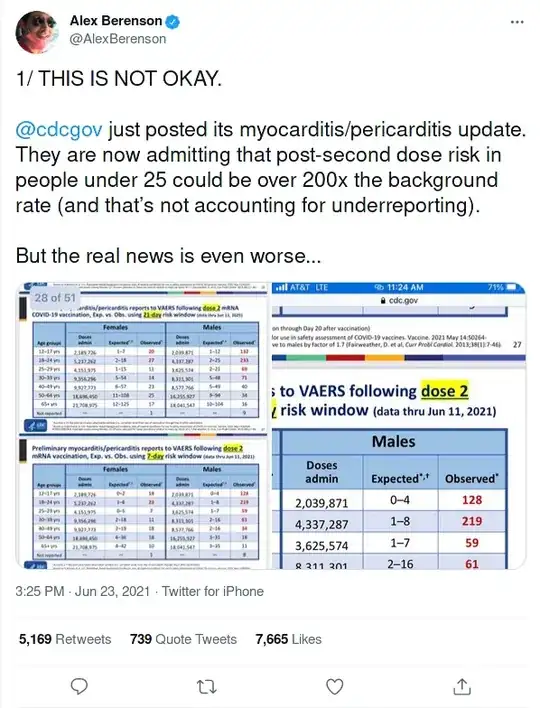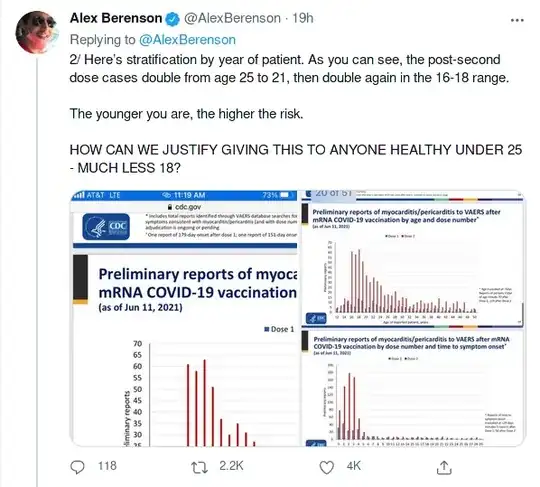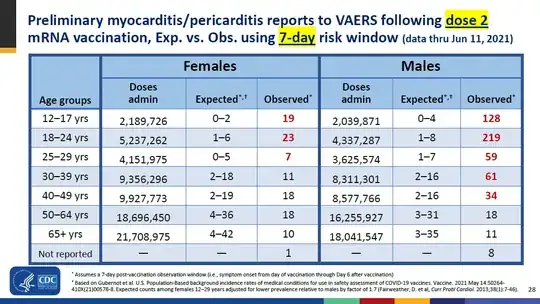Do young Pfizer COVID-19 vaccine recipients have 200x the background rate of myocarditis/pericarditis?
No.
The CDC has been investigating cases of myocarditis and pericarditis reported to the Vaccine Adverse Event Reporting System (VAERS) after receiving doses of either mRNA vaccine approved in the US (Pfizer or Moderna). (Note: Cases reported to VAERS are not necessarily related to the vaccine.
In this presentation on CDC.gov, slides 25, 26, 27, and 28 present the data screenshotted in the first Tweet. If you take a look for yourself, nowhere do the cases reported to VAERS exceed the midpoint of expected cases by 200x.
When looking at cases within 7 days following the second dose of a mRNA COVID-19 vaccination, for males 18-24 years, the expected range is 1-8 cases. 219 cases were reported to VAERS. This might be how the tweeter got his figure for a "over 200x background rate of myocarditis/pericarditis." However, I don't consider this accurate.
Going into the math for each population that is under 25 (12-17 year olds and 18-24 year olds):
Slide 25 compares the expected and reported cases of myocarditis/pericarditis within 21 days following the first dose of a mRNA COVID-19 vaccination. If we take the midpoint of the range of expected cases, for females, the numbers are unremarkable. For males 12-17 years old, there's a 3.4 fold increase in VAERS-reported cases over the expected baseline. For males 18-24 years, there's a 3 fold increase.
Slide 26 compares the expected and reported cases of myocarditis/pericarditis within 7 days following the first dose of a mRNA COVID-19 vaccination. For females, the reported case numbers do not exceed the expected numbers (e.g. 6 reported cases when 1-8 are expected). For males 12-17 years old, there's a 9 fold increase. For males 18-24 years, there's a 8.2 fold increase.
Slide 27 compares the expected and reported cases of myocarditis/pericarditis within 21 days following the second dose of a mRNA COVID-19 vaccination. For females 12-17 years old, there's a 6.7 fold increase. For females 18-24 years old, a 3.4 fold increase. For males 12-17 years old, a 24 fold increase. For males 18-24 years, there's a 20.3 fold increase.
Finally, Slide 28 compares the expected and reported cases of myocarditis/pericarditis within 7 days following the second dose of a mRNA COVID-19 vaccination. For females 12-17 years old, there's a 19 fold increase (19 observed cases out of 0-2 expected). For females 18-24 years old, a 9.2 fold increase. For males 12-17 years old, a 64 fold increase. For males 18-24 years, there's a 31.3 fold increase.
In the above numbers, I'm taking the midpoint of the range of expected cases.
Here are my calculations, listed in a table.
| Dose # |
Days after dose |
Gender |
Age group |
Fold increase |
| 1 |
7 |
Females |
12-17 |
Within expected range |
| 1 |
7 |
Females |
18-24 |
Within expected range |
| 1 |
7 |
Males |
12-17 |
9.0 |
| 1 |
7 |
Males |
18-24 |
8.2 |
| 1 |
21 |
Females |
12-17 |
Within expected range |
| 1 |
21 |
Females |
18-24 |
Within expected range |
| 1 |
21 |
Males |
12-17 |
3.4 |
| 1 |
21 |
Males |
18-24 |
3.0 |
| 2 |
7 |
Females |
12-17 |
19.0 |
| 2 |
7 |
Females |
18-24 |
9.2 |
| 2 |
7 |
Males |
12-17 |
64.0 |
| 2 |
7 |
Males |
18-24 |
31.3 |
| 2 |
21 |
Females |
12-17 |
6.7 |
| 2 |
21 |
Females |
18-24 |
3.4 |
| 2 |
21 |
Males |
12-17 |
24.0 |
| 2 |
21 |
Males |
18-24 |
20.3 |


